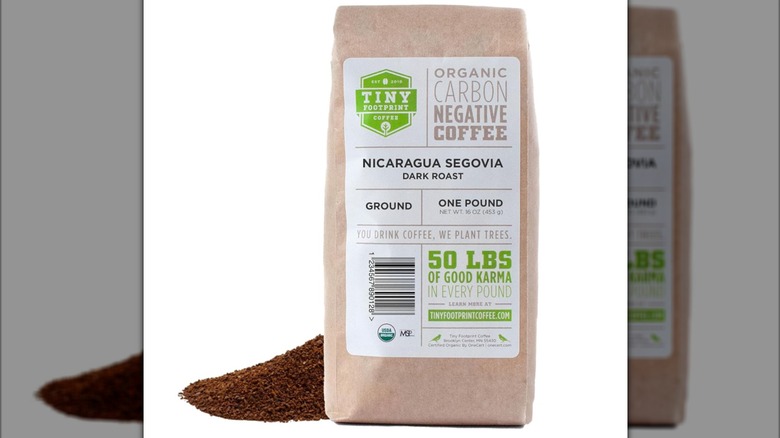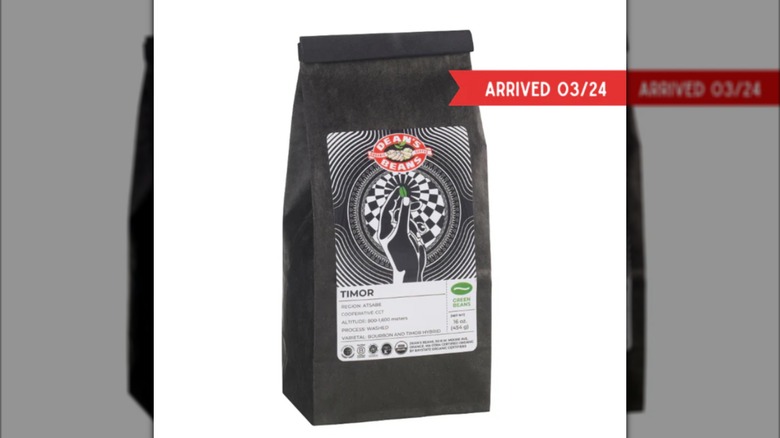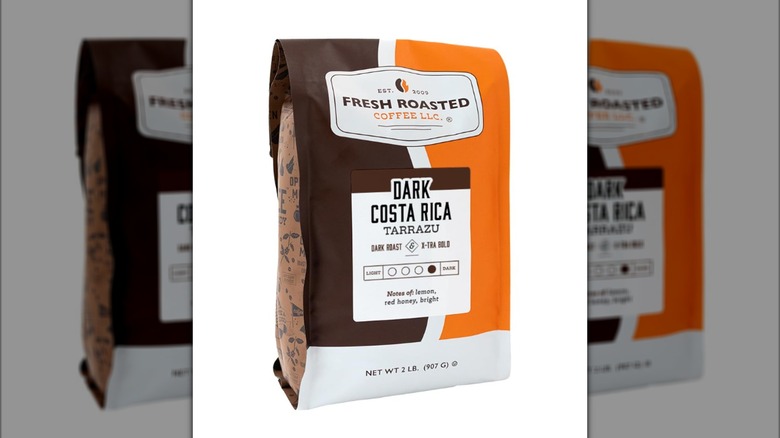12 Best Coffee Beans For Dark Roast Lovers
We may receive a commission on purchases made from links.
Whether you're the type to enjoy any coffee (as long as it's loaded with cream and sugar) or you're a specialty coffee professional who appreciates the nuances in each unadulterated cup, one thing holds true: roast level plays a crucial role. Most craft coffee connoisseurs are known to seek out lighter roasts, where intricate variations in flavor stand front and center. But there's no denying that dark roasts have earned their place at the table by providing a much-needed punch of intensity in the morning.
So, what makes a roast light or dark? The answer lies in their roasting temperature. Lighter roasts are typically roasted between 385 and 410 degrees Fahrenheit, while beans need to be raosted to at least 430 degrees Fahrenheit for dark roasts. You may hear coffee roasters referring to "cracks" in the roasting process. Coffee beans crack from the heat of the drum twice while roasting. Dark roasts are usually pulled soon after the bean's second crack, while light roasts never come near the second-crack mark.
Once you dive into the labyrinthine world of coffee, you'll discover that a coffee's origin plays as dramatic a role in its taste as roast level. To curate this list, I've incorporated my years of experience as a professional barista to showcase single-origin coffees that make ideal dark roasts. It takes an experienced eye to discern differences in darker coffees, and I've brewed and sampled countless dark roasts in an effort to determine their differences. So the next time you're on the hunt for a potent wake-up, look for coffees labeled with these origins for a flavorful, robust cup.
Sumatra
Coffee from the island of Sumatra in western Indonesia is among the most coveted coffee in the world. The humid, hot, tropical climate of Indonesia creates coffee that's revered for its intense yet smooth taste thanks to wet-hulled processing methods. This process — practiced only in Indonesia — involves keeping the coffee's fruit intact and then fermenting it overnight before removing the coffee cherry's protective layer. The coffee remains in a state of particularly high moisture content before it's air-dried and ready for export. This method produces a coffee that's uniquely earthy and syrupy, with low acidity and intense body.
It's impossible to bring up Indonesian coffee without mentioning Sumatra Mandheling. This coffee, named for the Mandailing people, reigns as the caviar of Indonesian coffee. Sumatra Mandheling is known to be best as a darker roast, where its balanced acidity and naturally sweet and spiced flavor profile — reminiscent of licorice and sweet chocolate — are enhanced with longer roasting times at higher temperatures. This coffee is largely produced on smallholder farms. So, choosing Sumatra Mandheling, this one from Volcanica, promotes ethical, fair-trade coffee practices for dark roast.
Guatemalan Antigua
Coffee from the Antigua Valley region of Guatemala is a quintessential example of Central American coffee. This coffee — cultivated at altitudes of over 1,500 meters above sea-level — is grown under the perfect conditions for a bold yet delicate dark roast. Volcanic soil and consistently temperate conditions combine with high-altitudes to create hard coffee beans. These beans (dubbed SHB for Strictly Hard Bean) can withstand higher roasting temperatures and longer roasting times necessary to create a dark-roasted cup 'o joe. Since it doesn't take much to ensure these beans stay intact, their flavor stays consistent, maintaining deeply sweet and toasty notes throughout the roasting process.
Antigua coffee is known for its smoked rum flavor, with hints of sweet caramel and middle-of-the-road balance and acidity. The full body coffee pairs well with rich, smoky flavors, contributing to its designation as an ideal dark roast. It's the ultimate cup to wake up to every morning, or, alternatively, to enjoy with sweet liqueur as a digestif. The boldness of this brew, like that of Volcanica's Guatemala Antigua Reserve, makes a nuanced espresso or a potent cup of drip coffee, where a dash of cream and sugar highlights toasty, caramel notes.
Indian Monsooned Malabar
While most of us don't think of India as one of the best countries for coffee, it's surprisingly among the top 10 producers of coffee beans worldwide, despite growing coffee in only three states. India's coffee market mainly focuses on robusta coffee, which is typically regarded as subpar compared to more ubiquitous arabica. But while India is known for producing the beans responsible for instant coffee's infamous taste, it also lays claim to a much more appealing brew.
Monsooned Malabar coffee — the most famous Indian coffee — owes its unmistakable flavor to an unorthodox processing method called monsooning. First practiced by accident on a trade ship in the 19th century, this method involves leaving coffee beans exposed to high winds and intense rains for the entirety of India's monsoon season; a period of time spanning about four months. The beans subsequently swell to become almost double the size of traditional coffee beans, yet are as light as air. This process gives Monsooned Malabar coffee a smoky aroma and distinct earthy, spicy, and gritty flavor that coats the palate.
The low acidity and full, smooth body of this coffee makes a deliciously unique single-origin espresso with thick crema. Or, try it in a dark-roasted espresso blend along with a favorite single-origin to make cappuccinos and lattés with elevated body.
Peruvian
Peru was the first country in South America to cultivate coffee beans, paving the way for the continent to be as synonymous with coffee as it is with breathtaking mountain scenery. In the mid-1700s, Peru received arabica coffee beans from Ecuador and then in the 1800s, entered the global coffee trade. In the early 21st century, Peru's coffee market transpired into one that advocates for fair pay and working conditions for farmers and responsible cultivation practices. These ethical sourcing and sustainable farming practices contribute to higher quality while making a positive impact on people and the environment. In the same vein, Peruvian coffee is also favored for its tendency to be organic. A vast percentage of Peru's small farms can't afford pricy pesticides for their coffee crops, thus making much of the country's coffee organic by nature.
There are six regions in Peru responsible for cultivating coffee: the Amazonas, San Martins, Andes, Chanchamayo, Cajamarca, and Southern Highlands. These high-altitude, mountainous coffee-growing conditions yield a hard coffee bean that can withstand long roasting times, so Peruvian coffee tends to be roasted medium to dark. A medium roasted Peruvian coffee leaves intricate, natural notes in its flavor intact, but roasting dark allows the coffee to shine as a smooth, potent drink, adding a hint of smokiness to its naturally sweet taste. It's light body and mild acidity create an easy-drinking dark roast that works wonders as a cold brew or iced coffee.
Tanzanian Peaberry
If you're looking to start an argument at your local third-wave coffeehouse, go ahead and mention peaberries. Peaberry coffee is known to be divisive among coffee fanatics, and for good reason. Rather than being a whole different variety of coffee, it comes from the same fruit as standard coffee, but there's one minute difference: peaberries occur when coffee cherries produce only one seed (or coffee bean) rather than the usual two per fruit. This occurs as a random genetic mutation that coffee growers have never been able to replicate, so in order to produce this coffee, the beans must be sorted; a meticulous process that drives up the cost. Some coffee aficionados argue that peaberries produce a sweeter, more well-rounded, brighter coffee, while others argue that this distinction is fueled by pretentiousness and coffee companies hungry for profit. Nevertheless, peaberry coffee — specifically Tanzanian peaberry — is still among the most sought-after coffees in the world.
Now, some of you coffee fanatics might scoff at the mention of Tanzanian peaberry on this list of coffees that make excellent dark roasts, but I urge you to let me plead my case. While most Tanzanian peaberries are roasted light to medium, having experimented with darker-roasted Tanzanian peaberry, there's something to be said for it. For this particular coffee, a standard dark roast would be considered overroasting, but a full city to full city plus roast can accentuate its flavor. Dark-roasted Tanzanian peaberry yields a sweeter cup, with delicate hints of smokiness that don't overpower its natural wine-like taste. Hints of bright berries or citrus and sweet spice remain prominent, carried along by its heavy, sometimes even syrupy mouthfeel.
Nicaraguan
Since Guatemala dwarfs Nicaragua in the Central American coffee scene, Nicaragua is sometimes viewed as an underappreciated region for coffee. In the mid-19th century, European immigrants recognized Nicaragua's ideal conditions for growing coffee, so they brought coffee to the country to begin its epic history as one of the underdogs of the international coffee market. The subsequent century proved to be successful for the Nicaraguan coffee industry, until a revolution and natural disasters disrupted production and trade. But the country has been on the up and up in recent years, continuing to make its mark with high-quality beans that offer exceptional flavor.
Like most coffees on this list, Nicaragua coffees are grown at high altitudes, resulting in hard coffee beans. They also tend to be shade grown, causing more lengthy growing times which yield more nuance and complexity. Unlike other high-altitude coffees, Nicaragua coffee is relatively low in acidity. Dark-roasted Nicaraguan beans — like this bag from Tiny Footprint Coffee — are particularly smooth and mellow, with Nicaragua's trademark citrusy, fruity undertones and noticeably balanced taste. The coffee's pungent aromatics add to its distinction. You'll likely notice bright citrus, chocolate, and hints of sugary spice.
Mexican Chiapas
The state of Chiapas in southern Mexico is arguably the country's most renowned coffee-growing region. With growing conditions similar to that of Guatemala — its neighbor to the south — this high-altitude coffee makes a delectable dark roast. The beans of Chiapas are known for their particularly round shape and, when roasted for longer periods of time at higher temperatures, they take on a glistening, oily sheen that indicates a deliciously luxurious dark roast coffee or espresso.
Mexican Chiapas coffee is an excellent choice for a versatile dark roast. Mexican coffee is famous for its nuttiness, and Chiapas coffee takes nuttiness to a new level. Roasting dark imbues this coffee with a smoked-nut flavor that's robust but still offers a hint of sweet, cinnamon-like spice with a creamy, chocolatey finish. This brew is sure to appease all coffee fans or find itself useful in any coffee application. Its well-balanced body and mild acidity make it an excellent (and my personal go-to) for a daily drinker.
Chiapas even acts as a delicious espresso. Keep in theme with the region and brew a couple shots of espresso to toss over ice and then add horchata for a sweet, creamy, Mexican refresher. Or use this coffee as a cold brew; its mild acidity creates an extra-mellow cold brew that's delicious and invigorating served black.
Colombian Supremo
I think it's safe to say that when most people in America think of a coffee-growing country, they immediately think of Colombia. Coffee from Colombia is globally ubiquitous, but particularly so in the United States, where it's the most widely recognized coffee origin. Suffice it to say that dark-roast loving Americans often gravitate toward Colombian for a robust brew based on how recognizable and universally loved it is.
Colombian Supremo coffee lives up to its name by being the highest-quality and most desirable Colombian coffee, as well as one of the largest coffee beans in the world. The characteristically extra-large beans are grown in a number of regions of Colombia, but usually high in the Andes mountains, where rich, fertile, volcanic soil can enrich coffee beans with complex tasting notes and textures.
Colombian Supremo is defined by its clean, bright, and sweet taste with a medium to full body and lively acidity. Its flavor can range from vanilla, chocolate, and caramel to toasted nuts, citrus, and spice, depending on the coffee's region, altitude, and roast level. Roasting Colombian Supremo to dark elevates its body and adds toasty notes to make it even more complex. Use this dark roast in sweet coffee drinks, especially with added cinnamon, cardamom, or other spices that taste delicious in coffee.
Brazilian
Brazil is the odd man out on this list for a few reasons, but nevertheless, it's the world's top coffee-producing country, with Brazilian coffee making up a whopping one-third of all coffee worldwide. Unlike the aforementioned coffee origins, Brazil sees little rainfall in its tropical climate, and tends to grow a significant portion of it's coffee at lower elevations (think at or below 1,100 meters below sea level). It's also known to produce a large amount of robusta coffee, along with the more popular arabica variety. Some coffee lovers opt for Brazilian coffee for its tendency to be dry-processed (otherwise known as naturally processed). This processing method requires beans to air-dry with the skin and fruit still intact, resulting in a sweeter brew.
Brazilian coffee's intense sweetness caused by natural processing takes well to a dark roast. Instead of high temperatures zapping any lingering sweetness from the beans, Brazilian beans stay flavorful and tend to be less bitter than most dark roasts thanks to their smooth, mellow taste. A full body, low acidity, and intense dessert notes — like creamy chocolate, toasty caramel, and smokey nuts — are accentuated when roasted dark. Pick Brazilian beans for espresso, from such a brand as Fresh Roasted Coffee, to create sugary, creamy lattes that still pack a fierce punch of rich coffee flavor.
Timor hybrid
Timor hybrid coffee is an obscure variety that you likely won't find at your local grocery store. This coffee is a cross-breed of the two most prominent species of coffee: arabica and robusta. Discovered on the island of Timor in the 1940s, this coffee grew rapidly in popularity thanks to its disease resistance. The discovery of this plant came in the nick of time, when a disease known as coffee rust was devastating coffee plants around the globe.
Today, this coffee is grown at its origin in Timor, as well as in Latin America — particularly Brazil — where it's known by the name Tim Tim. It also acts as the basis for which other hybrid coffees are developed. The sturdy branches of hybrids can reach deep underground to absorb nutrients, resulting in high cherry yield and, therefore, a more successful coffee production.
The intensity of robusta coffee and mellow sweetness of arabica combine in the Timor hybrid to create a coffee that makes an extremely potent dark roast. This coffee is typically used for mass market production in blends, to add richness and smokiness that doesn't overpower the way a pure robusta coffee can. If you manage to get your hands on a bag of pure Timor hybrid, props to you. You're more likely to find this coffee as a Catimor — a blend of the hybrid and a bourbon variety sourced from Indonesia. This coffee tends to be savory and profoundly earthy, and is therefore not for the average coffee enjoyer.
Ethiopian Harrar
The Harrar region of Ethiopia is one of the country's top coffee growing regions. Nestled high in Ethiopia's eastern Highlands, coffee is grown at elevations of around 1,400 to 2,000 meters, yielding tough, hard coffee beans with invigorating acidity. Like other African coffees, Ethiopian Harrar is known for its bright, floral, and fruity notes that come alive when combined with a syrupy body and tingling acidity.
Harrar is frequently described as tasting like blueberries, sometimes with hints of spice like cardamom or black pepper. These slightly tart, woody, and deeply aromatic notes make this Ethiopian coffee stand out among other African coffees, so be sure to inhale deeply with each sip.
While this coffee is more frequently found as a light to medium roast, roasting these beans to full city plus alters their flavor in surprising ways. Longer roasting times and higher temperatures usually remove a lot of the fruity essence in these beans. Instead, chocolatey notes appear alongside just a hint of berry, making a dark-roasted Ethiopian Harrar taste like a wine and chocolate tasting. This coffee is delicious on its own, but a touch of cream enhances its sweetness and complements its full body.
Costa Rican
Picturesque Costa Rica is just about as famous for its coffee as it is for being one of the top spots for the getaway of every vacationer's dreams. The country is home to nutrient-rich soil and a humid, tropical climate with defined dry and wet seasons that are ideal for growing coffee. Costa Rica's coffee is known for its light body and fruity notes, often including stone fruit, honey, citrus, and apricot. Some coffees, depending on the region, are also reminiscent of molasses or chocolate, so it's safe to say that this coffee is incredibly nuanced, fun, and fruity.
There are eight coffee-producing regions in Costa Rica, with each region's brew boasting distinct flavors. Of all regional Costa Rican coffees, Tarrazu dominates as the most acclaimed variety, with some arguing that it's the best coffee in the world. The body of this coffee is heavier than most other Costa Rican varieties, with incredible nuance.
Its bright fruit taste is accentuated by a hint of creamy vanilla and caramel notes, and when roasted dark, these creamy flavors become more apparent. Dark-roasted Tarrazu coffee — like this one from Fresh Roasted Coffee — is ideal for nearly all applications. Some coffee aficionados (myself included) would say that it's a crime against nature to dilute this exceptional brew with cream and sugar, so if you're lucky enough to snag a bag, enjoy it as a sipping espresso or create a heavenly pour over.












